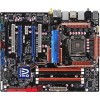- Qualcomm Launches Snapdragon 4 Gen 2 Mobile Platform
- AMD Launches Ryzen PRO 7000 Series Mobile & Desktop Platform
- Intel Launches Sleek Single-Slot Arc Pro A60 Workstation Graphics Card
- NVIDIA Announces Latest Ada Lovelace Additions: GeForce RTX 4060 Ti & RTX 4060
- Maxon Redshift With AMD Radeon GPU Rendering Support Now Available
ASUS P5E3 Premium WiFi-AP @n

X48 is new, but there are many boards already begging for your dollars. We are taking a look at the most robust of them all, the P5E3 Premium, which includes built-in WiFi, a great board design and fantastic overclocking abilities. It would almost be a perfect board if it weren’t for the $375 price tag.
Page 10 – Overclocking & Power Consumption
As mentioned earlier in the review, the P5E3 Premium features a rich BIOS, filled to the brim with overclocking potential. Considering it’s not a board catered to overclockers, it’s impressive just how much ASUS managed to fit in here. That’s only a good thing. Those who have no desire to turn all the dials don’t have to, but those who do want to will not be held back.
I mean ‘not held back’ literally. Using the Core 2 Duo E8400, I managed to hit 500MHz FSB with absolute ease. In order to achieve that figure, I bumped the northbridge to 1.55v, while all others were left at defaults. Although I haven’t done long-term testing on this setting, four hours of SP2004 passed without error, along with a 3DMark Vantage triple run.
Pushing even further though, I found 525MHz to be attainable, although due to time constraints, I haven’t been able to find if it’s truly stable. This was only achieved by bumping the NB voltage to 1.57v.

Using the same Quad-Core QX9650 that we used during testing, I couldn’t go beyond 470MHz FSB. That was stable, however. Going higher wasn’t. Moving to the Dual-Core took the virtual cover off the pot though, as I hit 540MHz with ease, though obviously not stable. This board has huge overclocking ability… it’s just up to you to find its sweet spot.
In my tests, this board is incredibly fussy with voltages. While 500MHz FSB was stable with 1.55v, it wasn’t at all with 1.59v or 1.51v. This becomes even more true going higher. You will need to spend some time changing the NB voltage value and seeing where it gets you. It may vary from CPU to CPU, but it’s a given that a Dual-Core will allow you to hit the highest possible FSB on the board.
So while I don’t have a conclusive figure, I do know 500MHz was stable during my tests, and the board’s very willing to go higher.
Power Consumption
To capture power consumption, we use a Kill-A-Watt which is plugged directly into the wall, with our PC plugged into it. The monitor and speakers are plugged into a different socket, so our figures here show what our entire PC draw is and nothing else.
Please note that these figures include the Corsair Nautilus 500 water-cooling system, as it feeds off of our computers power. Only one hard drive is plugged in during this testing, and the lone accessory used is a RAM fan. The network adapters are enabled, but no LAN cable is plugged in.
We test grab figures while the machine is idle, and also when the machine is utilizing half of the CPU (QX9650). We then continue to let the 50% CPU usage continue while we load up 3DMark Vantage, to grab a realistic from normal usage. In this case, it would assume playing a game that happens to utilize the CPU well.

The boards all performed well here. The P5E3, even with it’s WiFi adapter, didn’t manage to suck down extra power when compared to the other boards. The beefiest board looks to be Gigabyte’s X48T-DQ6, but all perform too close to one another to actually have a winner.
|
|
Support our efforts! With ad revenue at an all-time low for written websites, we're relying more than ever on reader support to help us continue putting so much effort into this type of content. You can support us by becoming a Patron, or by using our Amazon shopping affiliate links listed through our articles. Thanks for your support!





